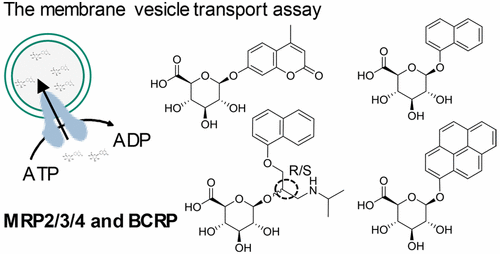当前位置:
X-MOL 学术
›
Mol. Pharmaceutics
›
论文详情
Our official English website, www.x-mol.net, welcomes your
feedback! (Note: you will need to create a separate account there.)
Selectivity in the Efflux of Glucuronides by Human Transporters: MRP4 Is Highly Active toward 4-Methylumbelliferone and 1-Naphthol Glucuronides, while MRP3 Exhibits Stereoselective Propranolol Glucuronide Transport
Molecular Pharmaceutics ( IF 4.5 ) Pub Date : 2017-09-13 00:00:00 , DOI: 10.1021/acs.molpharmaceut.7b00366 Erkka Järvinen 1 , Johanna Troberg 1 , Heidi Kidron 1 , Moshe Finel 1
Molecular Pharmaceutics ( IF 4.5 ) Pub Date : 2017-09-13 00:00:00 , DOI: 10.1021/acs.molpharmaceut.7b00366 Erkka Järvinen 1 , Johanna Troberg 1 , Heidi Kidron 1 , Moshe Finel 1
Affiliation

|
Xenobiotic and endobiotic glucuronides, which are generated in hepatic and intestinal epithelial cells, are excreted via efflux transporters. Multidrug resistance proteins 2–4 (MRP2–MRP4) and the breast cancer resistance protein (BCRP) are efflux transporters that are expressed in these polarized cells, on either the basolateral or apical membranes. Their localization, along with expression levels, affects the glucuronide excretion pathways. We have studied the transport of three planar cyclic glucuronides and glucuronides of the two propranolol enantiomers, by the vesicular transport assay, using vesicles from baculovirus-infected insect cells expressing human MRP2, MRP3, MRP4, or BCRP. The transport of estradiol-17β-glucuronide by recombinant MRP2–4 and BCRP, as demonstrated by kinetic values, were within the ranges previously reported. Our results revealed high transport rates and apparent affinity of MRP4 toward the glucuronides of 4-methylumbelliferone, 1-naphthol, and 1-hydroxypyrene (Km values of 168, 13, and 3 μM, respectively) in comparison to MRP3 (Km values of 278, 98, and 8 μM, respectively). MRP3 exhibited lower rates, but stereoselective transport of propranolol glucuronides, with higher affinity toward the R-enantiomer than the S-enantiomer (Km values 154 vs 434 μM). The glucuronide of propranolol R-enantiomer was not significantly transported by either MRP2, MRP4, or BCRP. Of the tested small glucuronides in this study, BCRP transported only 1-hydroxypyrene glucuronide, at very high rates and high apparent affinity (Vmax and Km values of 4400 pmol/mg/min and 11 μM). The transport activity of MRP2 with all of the studied small glucuronides was relatively very low, even though it transported the reference compound, estradiol-17β-glucuronide, at a high rate (Vmax = 3500 pmol/mg/min). Our results provide new information, at the molecular level, of efflux transport of the tested glucuronides, which could explain their disposition in vivo, as well as provide new tools for in vitro studies of MRP3, MRP4, and BCRP.
中文翻译:

人类转运蛋白对葡糖醛酸苷外排的选择性:MRP4对4-甲基伞形酮和1-萘酚葡糖醛酸具有高活性,而MRP3则显示立体选择性的普萘洛尔葡糖醛酸苷转运。
肝和肠上皮细胞中产生的异生和内生葡糖醛酸苷通过外排转运蛋白排泄。多药耐药蛋白2–4(MRP2–MRP4)和乳腺癌耐药蛋白(BCRP)是在这些极化细胞的基底外侧或顶膜上表达的外向转运蛋白。它们的定位以及表达水平会影响葡糖苷酸的排泄途径。我们使用表达人MRP2,MRP3,MRP4或BCRP的杆状病毒感染昆虫细胞的囊泡,通过囊泡转运试验研究了三种平面环状葡萄糖醛酸化物和两种普萘洛尔对映体的葡萄糖醛酸化物的转运。动力学值证明,重组MRP2-4和BCRP对雌二醇17β-葡萄糖醛酸的转运在先前报道的范围内。ķ米168,图13,和图3μM,分别地)的相比,MRP3(值ķ米278,98和8微米的值,分别地)。MRP3表现出较低的速率,但普萘洛尔葡糖醛酸内酯的立体选择性转运,对R-对映体的亲和力高于S-对映体(K m值154 vs 434μM)。MRP2,MRP4或BCRP均未显着转运普萘洛尔R对映异构体的葡糖醛酸苷。在这项研究中测试的小葡糖醛酸中,BCRP仅以极高的速率和很高的表观亲和力(V max和K m值4400 pmol / mg / min和11μM)。尽管MRP2以较高的速率(V max = 3500 pmol / mg / min)运输了参考化合物雌二醇-17β-葡萄糖醛酸苷,但其与所有研究的小葡糖醛酸苷的运输活性相对较低。我们的结果在分子水平上提供了被测葡糖苷酸外排转运的新信息,可以解释它们在体内的分布,并为MRP3,MRP4和BCRP的体外研究提供了新的工具。
更新日期:2017-09-13
中文翻译:

人类转运蛋白对葡糖醛酸苷外排的选择性:MRP4对4-甲基伞形酮和1-萘酚葡糖醛酸具有高活性,而MRP3则显示立体选择性的普萘洛尔葡糖醛酸苷转运。
肝和肠上皮细胞中产生的异生和内生葡糖醛酸苷通过外排转运蛋白排泄。多药耐药蛋白2–4(MRP2–MRP4)和乳腺癌耐药蛋白(BCRP)是在这些极化细胞的基底外侧或顶膜上表达的外向转运蛋白。它们的定位以及表达水平会影响葡糖苷酸的排泄途径。我们使用表达人MRP2,MRP3,MRP4或BCRP的杆状病毒感染昆虫细胞的囊泡,通过囊泡转运试验研究了三种平面环状葡萄糖醛酸化物和两种普萘洛尔对映体的葡萄糖醛酸化物的转运。动力学值证明,重组MRP2-4和BCRP对雌二醇17β-葡萄糖醛酸的转运在先前报道的范围内。ķ米168,图13,和图3μM,分别地)的相比,MRP3(值ķ米278,98和8微米的值,分别地)。MRP3表现出较低的速率,但普萘洛尔葡糖醛酸内酯的立体选择性转运,对R-对映体的亲和力高于S-对映体(K m值154 vs 434μM)。MRP2,MRP4或BCRP均未显着转运普萘洛尔R对映异构体的葡糖醛酸苷。在这项研究中测试的小葡糖醛酸中,BCRP仅以极高的速率和很高的表观亲和力(V max和K m值4400 pmol / mg / min和11μM)。尽管MRP2以较高的速率(V max = 3500 pmol / mg / min)运输了参考化合物雌二醇-17β-葡萄糖醛酸苷,但其与所有研究的小葡糖醛酸苷的运输活性相对较低。我们的结果在分子水平上提供了被测葡糖苷酸外排转运的新信息,可以解释它们在体内的分布,并为MRP3,MRP4和BCRP的体外研究提供了新的工具。











































 京公网安备 11010802027423号
京公网安备 11010802027423号